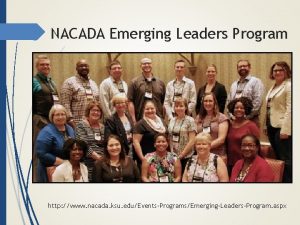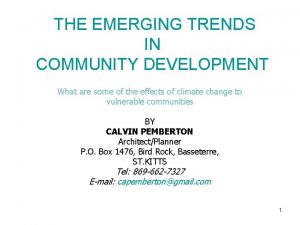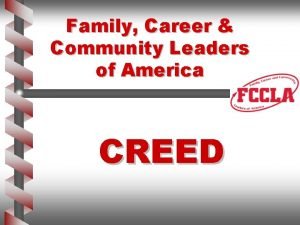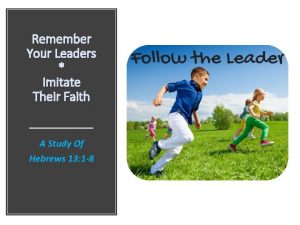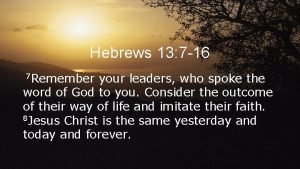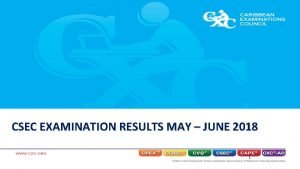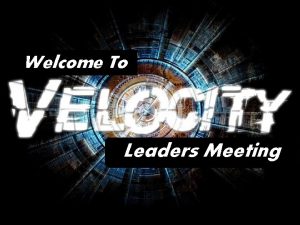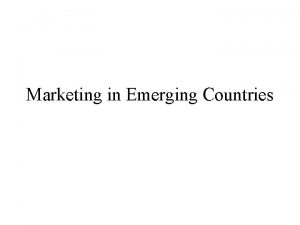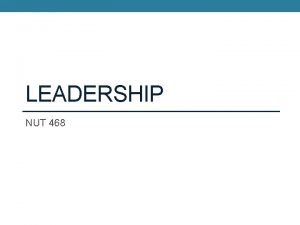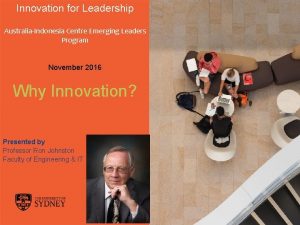Leadership in your Community Emerging Leaders May 2018














- Slides: 14

Leadership in your Community Emerging Leaders, May 2018 seeing beyond vision loss

The toolbox By the end of this session you will know: • How CNIB defines advocacy • Different types of barriers • Different types of advocacy • How to create your own advocacy plan for your local issue seeing beyond vision loss

Are you an advocate? seeing beyond vision loss

What is advocacy? “Advocacy is persuading a person with influence, the public, businesses, organizations or government to change attitudes, policies and/or practices about an issue. ” seeing beyond vision loss

Different types of Advocacy • • • Raising Awareness Self Advocacy Individual Third party Systemic seeing beyond vision loss

What are barriers to accessibility? • • • Information and Communication Attitudinal Technological Policy and Practice Physical seeing beyond vision loss

Advocacy 101 1. Define Issue 2. Research and Evidence 3. Audience and Key Messages 4. Stakeholder Relations 5. Timing 6. Monitoring success seeing beyond vision loss

Step 1: Define the Issue • • • Better to be too specific than too vague Need to reflect priorities of CNIB – Strategic Plan Needs to be important to society/decision makers Must be actionable/fixable If it does not meet this criteria – provide resources for self advocacy seeing beyond vision loss

Step 2: Research and Evidence • “Effective policy advocacy is built on hard evidence and a compelling narrative on an issue that matters” • That being said, research doesn’t always mean “Research” • Demonstrate the issue – what about the solution? seeing beyond vision loss

• • Step 3: Audience and Key Messaging Find the right person – balance between specificity and influence. How will you find them? Most of the time, the “general public” will be an audience Not trying to change minds through arguments, but fitting your argument into their framework Key messages structure: 1) What is the issue? 2) Why do we care? 3) What can we do? seeing beyond vision loss

Step 4: Friend or Foe? • • Find not only the usual, but also unlikely allies Power mapping – who are your opponents? Beware the scorpion! Derek Sivers – How to Start a Movement video: https: //www. ted. com/talks/derek_sivers_how_to_start_a_move ment#t-159162 seeing beyond vision loss

Step 5: Timing • • Sometimes it’s ASAP – particularly for individual advocacy issues Sometimes tie it in to another milestone or meeting Budget and political cycles Sometimes there is no good time – keep knocking on the window and one day it will open seeing beyond vision loss

Step 6: Monitoring Success seeing beyond vision loss

Our “ask(s)” • • CNIB. ca/Ontario for advocate volunteer role description, advocacy manual and advocacy toolkit. We will be checking in with Emerging Leaders to see how the advocacy issue you chose in this session is developing seeing beyond vision loss
 Deca prepares emerging leaders and entrepreneurs
Deca prepares emerging leaders and entrepreneurs World heart federation emerging leaders
World heart federation emerging leaders Nacada.ksu.edu
Nacada.ksu.edu Trish livingston deakin
Trish livingston deakin Emerging trends in community development
Emerging trends in community development B a f c j e
B a f c j e Fccla creed
Fccla creed Army leaders book
Army leaders book Imitate the faith of your leaders
Imitate the faith of your leaders Remember your leaders ubt
Remember your leaders ubt Cxc results 2018 may/june
Cxc results 2018 may/june Americanophilia
Americanophilia Transactional leadership
Transactional leadership Adaptive leadership theory
Adaptive leadership theory Enthusiastic beginner disillusioned learner
Enthusiastic beginner disillusioned learner


